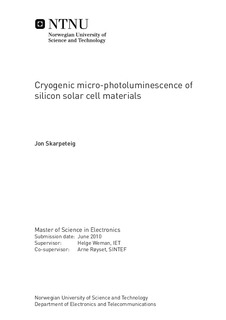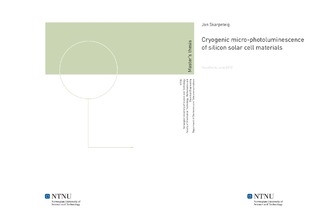| dc.description.abstract | A literature review of relevant luminescence spectra for silicon solar cell materials has been performed. Three multi crystalline silicon samples in particular has been the focus of attention, one electronic grade sample R6, and two solar grade samples ES1, and MH2, where MH2 has added chromium. A list of relevant luminescence spectra has been compiled, and can be found in the appendix.The samples was measured using low temperature micro photoluminescence. They where cooled down by liquid helium in a cryostat, and excited using a laser. Photoluminescence was captured by a camera mounted on a spectrometer. Noise components was measured and removed, but are subject to changes in between measurements, causing some unwanted artifacts to appear in the end result.Luminescence due to P and B doping atoms are identified in ES1, and MH2 as expected, and a weak boron bound exciton line is also present in the clean sample R6. R6 also show signs of having a carbon-carbon complex impurity forming at grain boundaries. Lines attributed to chromium boron pairs where not observed in MH2, presumably due to the lack of such pairs. ES1 exhibits a luminescence attributed to a higher quality material, than both MH2, and R6. Expected behavior is for R6 to have such traits, but this is not the case. The reason for ES1 to show this enhanced luminescence is not known. Lines attributed to dislocations are observed in all the samples, but consist of less intense peaks than expected.Local heating is a severe problem using micro photoluminescence. Bound excitons, impurity lines, and dislocation related lines, all loose intensity at higher temperatures. The intrinsic TO line also have a substantial broadening with respect to energies, suggesting that local temperatures are as much as 70K higher than the sample holder temperature, when exciting with 128 mW using a 2 µm spot diameter. | nb_NO |

